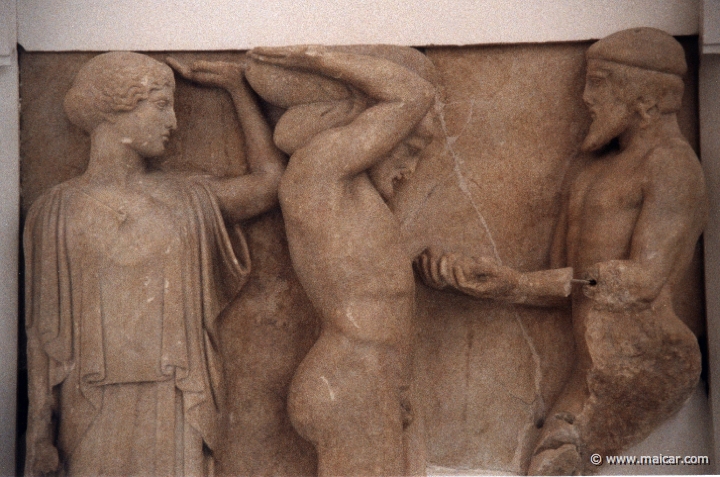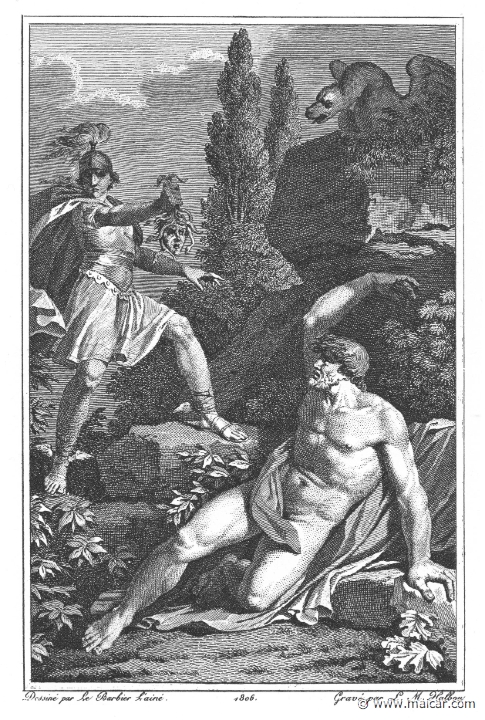 |
|
|

|
Atlas holding the sky. 7201: Atlante sostiene la volta celeste 2C AD. Collezione Farnese. National Archaeological Museum, Naples.
|
|
|
"Here is Atlas holding heaven, but he will let go the apples." (Old inscription. Pausanias, Description of Greece 5.18.4).
|
|
Some say that the Titan Atlas worked out the science of astrology and discovered the spherical nature of the stars. But he is best known for bearing on his shoulders the pillars that keep earth and heaven apart. This burden, a heavy one and difficult to grasp, is the punishment Zeus imposed on him for having been the leader of the TITANS during their war against the OLYMPIANS (see Titanomachy). And Atlas, they say, though pre-eminent in strength, moans as he holds the vault of the sky on his back.
Called Arcadian king
Atlas is said to have reigned in Arcadia and have been succeeded by Deimas, son of Dardanus 1, the king who is at the origin of the royal house of Troy.
Atlas in the far west
But Atlas is also said to have ruled in northwestern Africa where he had, among other riches, a tree with golden leaves, golden branches, and golden fruits. Some affirm that these are the Golden Apples that were given by Gaia, as a wedding present, to Zeus and Hera.
Atlas turned into stone
To this realm, some say, came Perseus 1 after having killed Medusa 1, and presenting himself as son of Zeus, asked Atlas for hospitality and a chance to rest. But Atlas, who had enclosed his orchard with walls and put a dragon to watch the tree and its golden fruits, remembering Themis' prophecy
"Atlas, the time will come when your tree will be spoiled of its gold by a son of Zeus." (Themis to Atlas. Ovid, Metamorphoses 4.643).
advised Perseus 1 to leave, adding threats to his words. It was then that Perseus 1, holding the head of Medusa 1 in front of the Atlas' eyes, turned him into stone, and the huge stone into which the Titan was changed is today called Mount Atlas.
Mount Atlas
The Libyans living around this chain of mountains, they say, never ate a living creature, for they lived on wild vines, and saw no dreams in their sleep. And those Libyans living closest to these mountains also professed to know the measurements of the earth. These mountains are very high and were believed to touch heaven, but were altogether inaccessible because of the density of trees.
|

|
Athena assists Heracles 1 in holding the sky as Atlas returns with the apples. 6708: Athena, Heracles, and Atlas with the apples of the Hesperides. Temple of Zeus, Olympia, c. 460 BC. Archaeological Museum, Olympia.
|
|
The Golden Apples
Yet some may think that the account of Atlas-into-stone cannot refer to the same Atlas, for Heracles 1 deceived Atlas, and he had not been able to do it, being as he was a descendant of Perseus 1, if his ancestor had turned Atlas into stone with the help of Medusa 1's dreaded head, as it is told. For, they say, when Heracles 1 went in search of the Golden Apples of the HESPERIDES, which some think were in the north and not in the west, Prometheus 1 (Atlas' brother) advised him no to fetch the apples himself, but to send Atlas instead. So Heracles 1, following Prometheus 1's instructions, offered to hold the sky while Atlas fetched the golden apples. But on his return Atlas, who apparently felt released, said that he would deliver the apples himself to Eurystheus, the man who had asked for them. But Heracles 1 asked Atlas to hold the sky for a moment while he placed a pad on his head, and when Atlas held the sky again, Heracles 1 picked up the apples and left. This is why Atlas still holds the sky.
Descendants of Atlas
The Pelopides (descendants of Pelops 1) may be called descendants of Atlas because Pelops 1's wife was the daughter of a Pleiad and the PLEIADES were daughters of Atlas. Also, Pelops 1's mother could have been a daughter of Atlas. The Pelopides ruled Mycenae from King Eurystheus until the return of the HERACLIDES. Among the Thebans, Nycteus 2 and Lycus 5 were said to have come from Euboea, but they too might be descendants of Atlas, and so could be Amphion 1, grandson of Nycteus 2. Amphion 1 was married to Pelops 1's sister Niobe 2, mother of the NIOBIDS. The Trojans were also descendants of Atlas, as their ancestor Dardanus 1 was son of one of the PLEIADES.
|
| Family |
|
|
|
|
|
|
|
|
|
|
|
|
|
|
|
|
|
|
Iapetus 1 is one of the TITANS and Clymene 1 one of the OCEANIDS.
Asia 2 is counted among the OCEANIDS.
This parentage is only found in the myth of Atlantis. Cleito 2 is daughter of Evenor 4 and Leucippe 6, inhabitants of Atlantis all three.
|
|

|
01145: Perseus and Atlas. "... and, himself turning his back, he held out from his left hand the ghastly Medusa-head." (Ov. Met. 4.655). Guillaume T. de Villenave, Les Métamorphoses d'Ovide (Paris, Didot 1806–07). Engravings after originals by Jean-Jacques François Le Barbier (1739–1826), Nicolas André Monsiau (1754–1837), and Jean-Michel Moreau (1741–1814).
|
|
|
|
|
"a)", "b)", etc. = different versions.
Pleione is a daughter of Oceanus and Tethys, that is an Oceanid.
Hyas was killed while hunting by a lion (some say a Libyan lionness) or a boar.
|
|
|
|
Hesperis was daughter of Zeus and Themis, or perhaps of Hesperus 2, a Titan, son of Iapetus 1 and Clymene 1. The HESPERIDES are the sisters who guarded the the tree with the Golden Apples.
|
|
|
|
Aethra 1 is one of the OCEANIDS.
|
|
|
|
|
|
|
Maera 3 is said to have been the wife of Tegeates, son of impious Lycaon 2. Tegeates founded Tegea in Arcadia, and some of his children by Maera 3 emigrated to Crete.
Family chart of Atlas is at Three Main Ancestors.
|
|
|
|
|
|